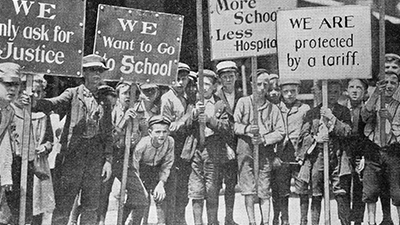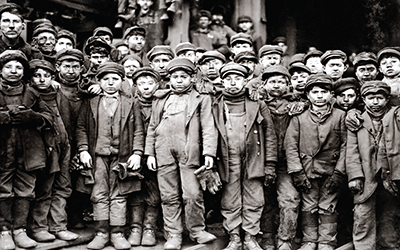Child Labor
Teacher Resources
Driving Question: How did ideas about child labor evolve during the long nineteenth century?
Child labor became part of industrial life. Children worked long hours in dangerous jobs, and their stories helped spark a movement to rethink labor, rights, and the meaning of childhood.
Learning Objectives:
- Analyze how shifts in ideas about childhood led to labor reforms in the long nineteenth century.
- Use the historical thinking skill of contextualization to examine the use of child labor and why perceptions changed during this era.
Vocab Terms:
- activism
- exploitation
- industrial capitalism
- literacy
- reform
- regulation
- union
Opener: Child Labor
To teach this lesson step, refer to page 2 of the Lesson 4.5 Teaching Guide.
Listen to one child’s story—a firsthand account that helps reveal the human impact of the Industrial Revolution.
Children at Work
AI Detective: Reformers and Their Opponents—Real and Imagined
- Ask AI to generate a set of quotes from reformers and their opponents. Ask for several false quotes including misattributions, misdates, and quotes from people who never existed.
- Then, ask students to read the quotes and flag anything that seems suspicious. Together, label each claim as “true,” “needs revision,” or “false,” and discuss why.
Why this works: This activity strengthens source analysis and skepticism. Students confront AI’s tendency to invent information, learning to validate claims with historical evidence and deepening their understanding of real reform debates.
These materials will help you understand how child labor fit into the world of the Industrial Revolution—and how reformers began to push for change.
-
Guiding Questions
-
Before you read
Preview the questions below, and then skim the article. Be sure to look at the section headings and any images.
While you read
Look for answers to these questions:
- How did Lewis Hine support the child labor reform movement?
- Why did child labor grow in places like Europe and the US during this time?
- What moral arguments were made against child labor?
- How and why did labor unions oppose child labor?
- What happened to children’s roles once child labor was restricted or banned?
After you read
Respond to these questions: What tools or evidence helped people speak out against child labor? What might have made their argument even stronger?
Life as a Child
To teach this lesson step, refer to page 7 of the Lesson 4.5 Teaching Guide.
Child labor still exists around the today. Read more about how to connect the Sadler report to today by reading this thread in the OER Project Community Forum, Modern Day Child Labor Resource.
Get a closer look at what factory life was like for working children, and learn about powerful testimonies that helped spark demands for reform.
-
Guiding Questions
-
Before you watch
Preview the questions below, and then review the transcript.
While you watch
Look for answers to these questions:
- Why did such young children start working as nailers?
- How many nails did an eight-year-old girl make per hour, and how long did she work?
- How did nail masters cheat workers? How much were nailers paid?
- Who was Mary-Ann Bird, and why is her story important?
After you watch
Respond to this question: What does this video teach you about child labor and the power bosses had over working-class families?
Key Ideas
Closer: Child Labor
To teach this lesson step, refer to page 8 of the Lesson 4.5 Teaching Guide.
Prompt parsing is just one part of helping students become strong historical writers. Read the blog post "Writing historical essays - not as easy as it sounds!" to learn more.
Learning to effectively parse questions will help you improve the arguments you create and the evidence you choose to support them with.
Labor Data
To teach this lesson step, refer to page 9 of the Lesson 4.5 Teaching Guide.
The story of child labor extends beyond England, and, sadly, it extends beyond the long nineteenth century. This data exploration will help you understand how child labor changed, from the Industrial Revolution to the present.
-
Guiding Questions
-
Before you read
Preview the questions below, and then skim the article. Be sure to look at the section headings and any images.
While you read
Look for answers to these questions:
- Chart 1 shows a spike, when child labor in Italy started rising again instead of falling. Why do you think this spike occurred? Why don’t we see a similar spike in the UK or US?
- Charts 1 and 3 show dramatic decreases in child labor. Why doesn’t Chart 2 show this sort of dramatic decline?
- What does Chart 4 measure? Why do you think the percentages are so much higher than at the ends of Charts 1, 2, and 3?
- Why do you think Chart 5 lists “no data” for wealthy countries in Europe, North America, and elsewhere?
- There’s a lot of data missing from the “global” information in Charts 4 and 5. What impact does this have on our understanding of child labor?
After you read
Respond to this question: What do these charts about child labor tell us about how ideas surrounding child labor have changed since the Industrial Revolution?





